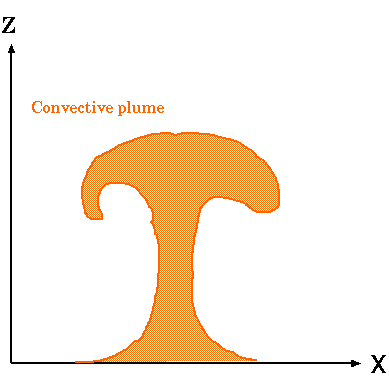|
3.d. Intensity of Convection (2): Transition Layer
|

|
|
Figure 8: Schematic figure of one dimensional "chimney" plume model.
|
According to the argument in the previous
section, Intensity of convection (2), the
daytime potential temperature difference of the conduction layer is
expected to be more than 6 K. However, the potential temperature
deviation of ascending convective plumes in the convection layer is
about 2 K. This difference is caused by the entrainment of relatively
cold air surrounding a plume during its ascent through a moderate
vertical temperature gradient between the conduction layer and the
convective layer. In the following sections, the region where
entrainment occurs is referred to as the transition layer.
Let us consider the influence of such entrainment on the potential
temperature deviation of convective plumes. Assume that at the root of
a plume, as illustrated by the blue frame in Figure
8, air with potential temperature
 is ascending from below the transition layer at velocity
is ascending from below the transition layer at velocity
 ,
and air with potential temperature ,
and air with potential temperature
 is exiting the convection layer at velocity
is exiting the convection layer at velocity
 .
Then .
Then
when considering the heat budget.
 can be estimated by the buoyancy force of a
convective plume ascending from the conduction layer and the turbulent
diffusion time of the conduction layer, can be estimated by the buoyancy force of a
convective plume ascending from the conduction layer and the turbulent
diffusion time of the conduction layer,
 ,
and ,
and
 can estimated from the work done by a convective plume in the
convection layer.
can estimated from the work done by a convective plume in the
convection layer.
Where  is the depth of the convection layer.
If we define is the depth of the convection layer.
If we define
 ,
which is the time needed for the convective plume to travel through
the convection layer with a constant potential temperature deviation, ,
which is the time needed for the convective plume to travel through
the convection layer with a constant potential temperature deviation,
 can be rewritten as
can be rewritten as
 |
(5) |
The influence of entrainment is determined by the ratio of the plume's
travel time to turbulent diffusion time.
By assuming that  is given as the potential temperature
difference of the conduction layer, we can estimate the potential
temperature deviation of a convective plume is given as the potential temperature
difference of the conduction layer, we can estimate the potential
temperature deviation of a convective plume
 in the convection layer by using Equation (5).
Consider daytime at 14:00 LT.
From Figure 7, we can adopt
in the convection layer by using Equation (5).
Consider daytime at 14:00 LT.
From Figure 7, we can adopt
 ≈ 40 m, and ≈ 40 m, and
 as 6 K. By using these values, as 6 K. By using these values,
which roughly coincides with those of plumes observed at 14:00 LT.
According to the above discussion, the potential temperature deviation
of ascending convective plumes can be estimated by using heat
flux  , depth of convection layer , depth of convection layer  , and
turbulent diffusion coefficient , and
turbulent diffusion coefficient  . Note that this
estimation does not describe the causality of the entire convection
field, since the magnitude of sensible heat flux included
in . Note that this
estimation does not describe the causality of the entire convection
field, since the magnitude of sensible heat flux included
in  and the value of the turbulent diffusion
coefficient are determined by the convective motion itself. and the value of the turbulent diffusion
coefficient are determined by the convective motion itself.
Furthermore, note that the estimation obtained by using Equation
(5) can only be done for the case where convection
is well developed, and hence, it can be assumed that
 < <  . When . When
 > >  ,
a strange result is obtained, ,
a strange result is obtained,
 > >  , which suggests
that the potential temperature deviation of convective plumes is
larger than the potential temperature difference in the conduction
layer. In such a case, it is more reasonable to assume that
entrainment rarely occurs. , which suggests
that the potential temperature deviation of convective plumes is
larger than the potential temperature difference in the conduction
layer. In such a case, it is more reasonable to assume that
entrainment rarely occurs.
|